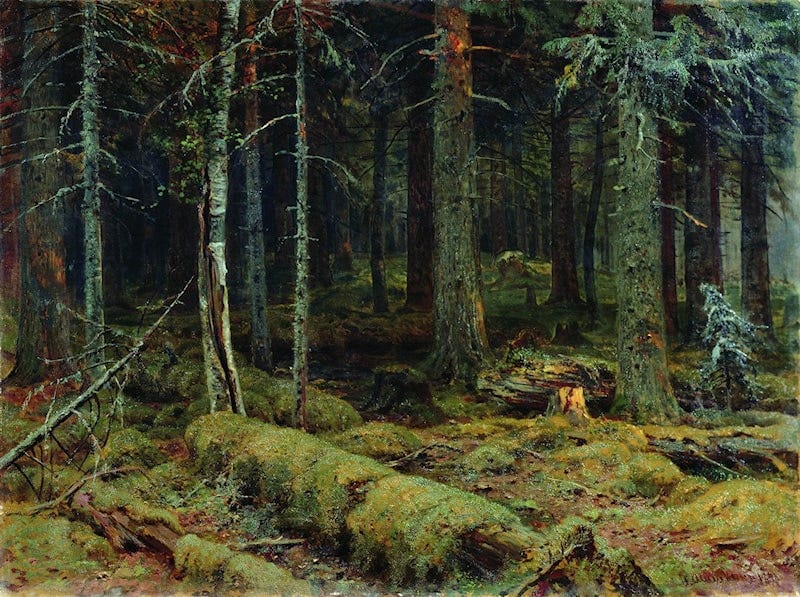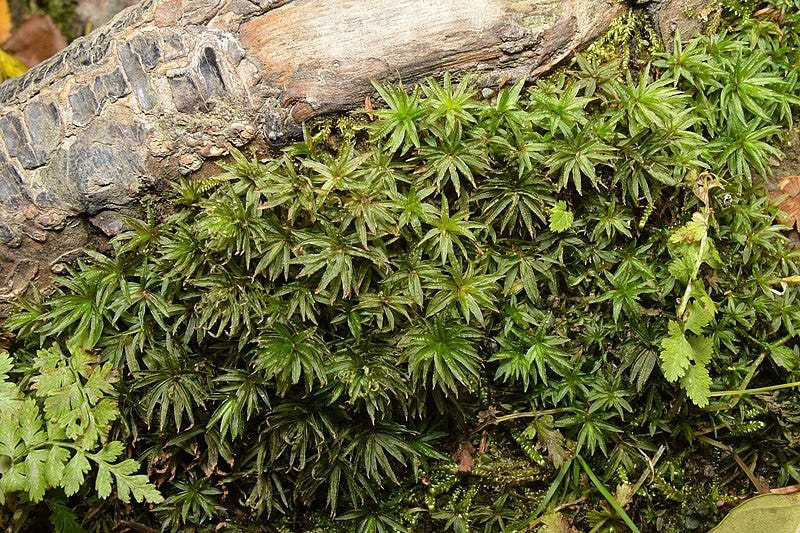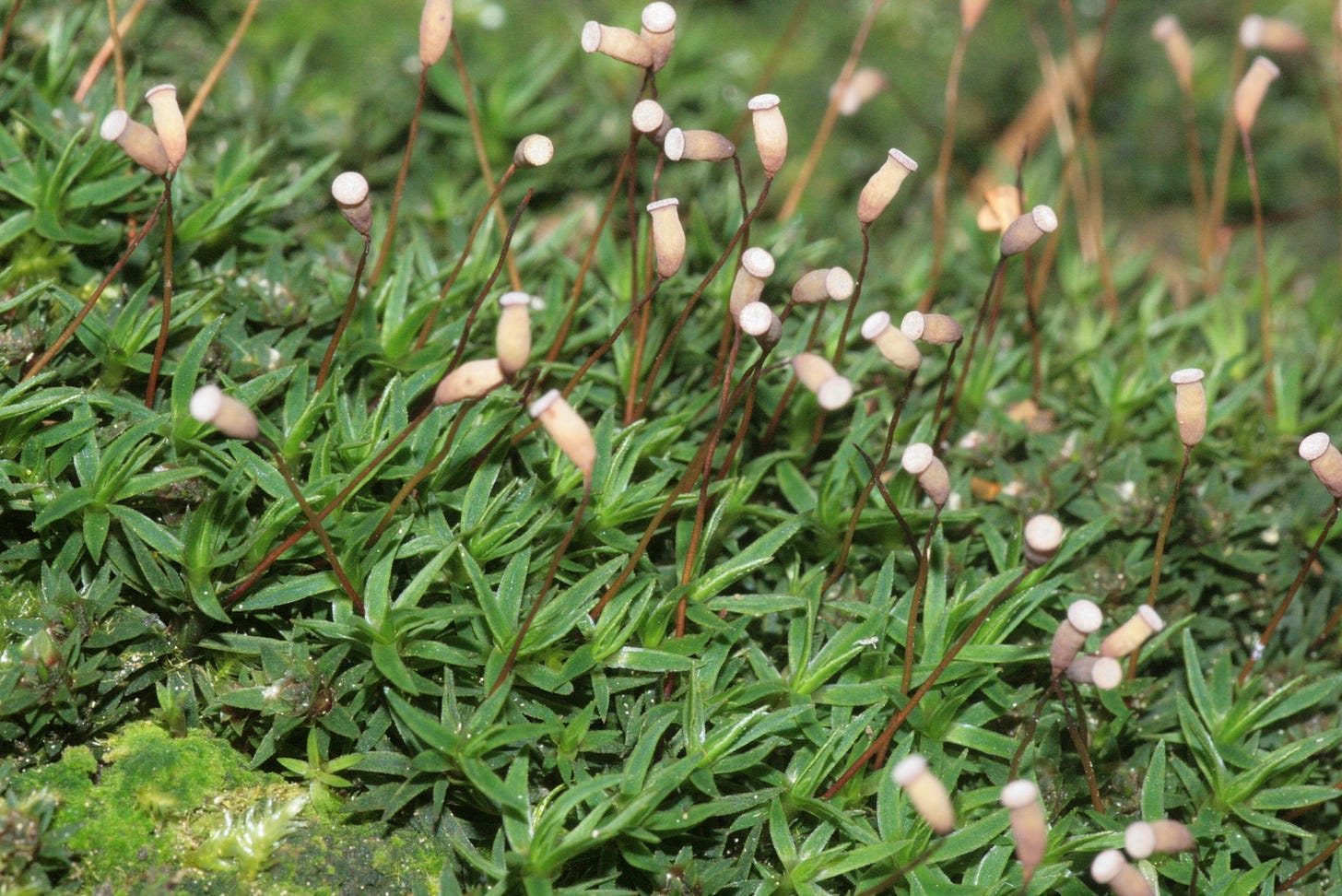ALSO KNOWN AS: Catharinea undulata, Atrichum undulatum, big star moss, common smoothcap, Wavy Catharinea, Żurawiec falisty (Polish, meaning wavy, cranelike moss)
How to know
moss that stands straight up
leaves that do backbends or curl like dolphins
dark green
This plant came to me after an interview with some profound experts of ecology. The program’s botanist smiled as she described this moss, holding her hand out as if she was caressing mountains in the distance. “Undulating moss” she said, “or something like that.” This proceeded to be a long discovery process of mosses, looking at old books on their shelves and iNaturalist. Online searches and reaching for family names: “Acrocarpus, they stay together.”
“Like pin cushion moss?” I asked. No, it’s a looser form.
“Catherine” was spoken in the muddle and thus began the research.
To Dance a Moss
The more we learn about plants the more we understand what fools we are. The name of the plant is one thing that gets constantly changed and realigned. It’s hard enough to go by this shifty handhold, but we can barely describe them precisely because they are so complex. Maybe this is why there is plant blindness.
Because plants are so very complicated they become hard to see. To truly see a plant we have to slow down to take in all the parts. We have to focus our eyes to strange, tiny, underground, interspecies or deeply subtle growth patterns. Sometimes all we can do is dance them and that’s name enough.
Undulating. This is the word that always comes up in relation to the soft movement of this moss. In a way that’s what mosses are: a physical manifestation of the way water rises up in the land - made manifest in chloro-filled bodies. If mosses eat the sunlight and make it into chlorophyll, they breathe water in a process called transpiration, a mechanism that costs them nothing. They take in the water like we take in air. Like our lungs only take in so much oxygen even when it is all around us. The moss too will only take in only the water it needs, releasing the rest out through their stomata - the tiny mouths that all plants have. If there is not enough water in the surface where the moss is growing, whether it be a log, a rock, or in the soil, the stomata will close to keep the water in the body of the plant.In small and important ways, moss lends to the forest’s ecosystem through this act of transpiration. By releasing water into the air the plants cool the place where they are and create moist conditions in the forest. All plants breathe in some way. You can see this on a very large scale by seeing the way clouds form over the Amazon rainforest. This is also why planting trees in urban environments is so vital (keeping in mind that, especially in New York City, many of these trees are grown in tight containers of sidewalk. It’s little short of a miracle that they survive at all.)
Find Catherine’s moss in temperate forests. It has been traveling the world for so many iterations of land’s movement it doesn’t see borders, but searches for cool and damp ecosystems. While prevalent in forests, these plants can also grow on heaths and some open areas. They are resilient to sun, though they prefer shade. There is information about it from Europe to Poland, to the Appalachian mountains and in British Columbia. They grow by streams or in ditches, beside roads in slightly acidic to neutral soils.
So Catherine’s moss is vaguely connected to the pincushion moss. It is an acrocarpus moss stands upright rather than sprawling. They grow slowly and create refined leaves that open out like the canopies of tiny trees or ripple along the ground like the fur of an old mammal. A pleurocarpus moss can look very much like a shag rug, messy, hairy, unkempt, the longhaired breed to the acrocarpus. You see them in streams where they flip like hair in intermittent waterfalls.
This moss if part of the order of aloe mosses, a precise group of mosses with lance-like leaves - like the aloe plant - with photosynthetic skin lamellae which allows them to process much more sunlight than most other species. You can see the traces of it as tiny dark lines running up and down the central nerve along the leaves. A gourmand of mosses you might say. Perhaps that’s why they’re so big. They love the sun, they expand like an aperture in the dark woods - huge as mosses go. Ironically, the more sun receive, the lighter green they become, until they are nearly yellow.
Catherine’s moss undulates in its own way. The botanist who had explained the moss to me was not illustrating mountains in the distance, or even swells on the forest floor. As she caressed the air she had shrunk all of us, bringing us to the level of Catherine’s moss itself. Everything about moss is small, even for the biggest varieties. It turns out the undulation of this plant is not in the form of it collectively as it washes over the forest floor, but singularly. She danced a leaf.
From a distance the colonies of moss blend like textile fibers blend together in our eyes. It undulates - not because it looks like waves on land. Not because of the way its leaves exhibit such strong arches like dolphins. Come close to Catherine’s moss and see the way those leaves ripple like they are underwater.
Royalty of the Forest Floor
This moss is Catherine, of the Great. And these plants do grow in Russia too, perhaps like reclining queens among pines. To have a moss be named after a queen - and Catherine the Great, no less, an impactful Queen in Russian history, could seem strange. But Catherine the Great was a unique kind of queen. Not necessarily “native” herself, but she brought sciences and human rights into Russia via the ideas of philosophers like Rousseau, Voltaire, and Diderot. Would a queen of the deepest forests not be the moss itself? Expanding in a beautiful, inspirational green, lightening the woodland’s floor. And it doesn’t take a second glance to see how proud this moss is. The growth is nothing short of hundreds of thousands of crowns, yes, royalty of the forest floor.
The moss does not have to reach taller than its tallest, 5cm to make royalty of the wood. These mosses are large - as mosses go, yet they can crown anything they find.
To further the themes of water which Catherine’s moss alludes, the tiny leaves look like fountains - or the tops of pineapples. Their lush leaves fill with water and exhibit lovely backbends with their lithe green bodies. When they dry they wither and contort into tight curls that look like atrophied fingers. But mosses have a way of reanimating, springing up with no more than a touch of rain. Catherine’s moss is one of the stronger types. It can reach desiccation, curling and nearly browning before it will finally die.
What is particularly noteworthy about this species is their sexual identity. Plants, as any living species, think a lot about reproduction. Catherine’s moss doesn’t follow any rules. is neither bisexual, nor a fixed sex. Some of Catherine’s moss will be in their female form and then become their male form. Sometimes they come up as male, sometimes they come up as female - and sometimes they change to become the sex they had not been before. No one knows why.
These mosses have a light - almost white - crown from which the sporophytes emerge. These capsules are long like the hefty packs of backpackers with little scarlet caps common to the Polytrichaceae family of which Catherine’s moss is a part on them as they mature. Sporophytes in mosses look a lot like the minuscule versions of the worms in Tatooine or the Shai-Hulud sandworms in Dune. They are nothing but open mouths and layers of teeth. In mosses these teeth are the peristomes of which there are 32, and from them, the sporophyte balloons, expand until the peristomes release the spores. But they release slowly. This moment - the release of the spores is choreographed with water with the presence of moisture these peristomes will release or withhold the spores until the condition is moist enough. The drops of water bring the spores to the gametophyte, a tiny chip of a plant attached to the forest floor and thus the new undulata will begin to form.
Because they are slow growing, they are slow taking. So splitting Catherine’s moss may not take as easily as other most loose Pleurocarpus species of moss. But on the other hand, these mosses are quite compact and do not leave room for opportunistic species to come in. They are resistant to invasive species, and prevalent to the point of exuberance in an ecosystem themselves, though not destructive.
Catherine’s moss is used by many animals as shelter and eaten by browsers in the forest. Traditionally moss has been used to treat wounds. It has astringent properties that allow wounds to heal and skin to repair. Moss borders death and forests. It borders soil and air, water and sun. It gives us soft lines. If Catherine’s moss were a queen would she not be perfect? Should the queen not always be rippling along the soil? Should a king not be as small as a breath? Should that tiny power not be some of the most valuable there is?
myth for catherine’s moss
Not to be confused with Mnium hornum or swan’s neck thyme moss has similar leaf patterns to Catherine’s moss. But their leaves turn slightly upward and inward. You see, the Catherine’s moss is really the ‘undulating’ one.
Or Pogonatum dentatum. This moss has the same leaves extending from a central stalk. But the leaves don’t bend at all. They stick out like tiny swords all around. They are much more rare as a moss species as well.
Forager Friendly?
Sure - harvest responsibly - never take the first, never take the last. Harvest less than 1/3 of what you see.
Sources:
https://mossandstonegardens.com/blog/knowing-your-acrocarp-from-you-pleurocarp-moss-rocks/
https://cabinetofcuriosities-greenfingers.blogspot.com/2010/02/undulating-mosses.html
https://www.inaturalist.org/taxa/124155-Atrichum-undulatum
https://www.naturespot.org/species/common-smoothcap
https://www.britishbryologicalsociety.org.uk/learning/species-finder/atrichum-undulatum/
https://linnet.geog.ubc.ca/Atlas/Atlas.aspx?sciname=Atrichum%20undulatum
https://www.worldfloraonline.org/taxon/wfo-0001192448
https://www.gbif.org/species/2673299
https://sjgmoss.wordpress.com/2017/02/15/atrichum-undulatum-•-common-smoothcap-moss/
https://www.britishbryologicalsociety.org.uk/wp-content/uploads/2020/12/Atrichum-undulatum.pdf
https://www.inaturalist.org/taxa/785240-Polytrichopsida
https://lithub.com/the-unlikely-friendship-between-a-philosopher-and-an-empress/
Mosses, Liverworts, and Hornworts: A Field Guide to Common Bryophytes of the Northeast, Ralph Pope, Cornell University Press, 2016
Gathering Moss, Robin Wall Kimmerer, Oregon State University Pree, 2020
https://petehillmansnaturephotography.wordpress.com/catherines-moss-atrichum-undulatum/
https://en.wikipedia.org/wiki/Transpiration
https://www.jstor.org/stable/pdf/3237990.pdf
https://tropicalisopods.com/products/catherines-moss-atrichum-undulatum
https://petehillmansnaturephotography.wordpress.com/catherines-moss-atrichum-undulatum/
https://pmc.ncbi.nlm.nih.gov/articles/PMC4977332/
http://flora.huh.harvard.edu/FloraData/001/WebFiles/fna27/FNA27-1-Morphology.htm
https://fieldguide.mt.gov/speciesDetail.aspx?elcode=NBMUS0M080

Thank you, Claudia who gave form to the leaves, Josie who found the name ‘Catherine’s moss’ and the Farmscape Ecology Program team






